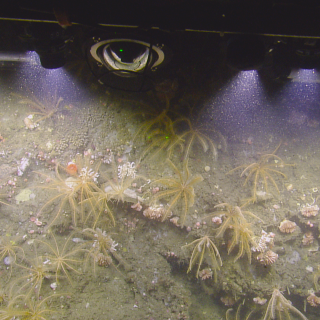Sampling Glass Sponges in the Olympic Coast National Marine Sanctuary
We know very little about deep-sea sponges, but we’re sure these aquatic invertebrates are quite abundant in the Olympic Coast National Marine Sanctuary (OCNMS)! To date, science has described over 8,500 species of sponges around the world but there are likely more than 25,000, making it very likely that many specimens collected by researchers aboard E/V Nautilus could be a new, previously undescribed species.
While diving in this biologically diverse region, our team explored the aptly named “Sponge Garden” to collect glass sponges, a distinct group most common in the deep, dark, and cold water environments that we dive in.
Previous cruises in and around the canyons near OCNMS found dense aggregations of large glass sponges. Further research determined that at least four of the sponge samples that we collected represented new species — one of which is thought to represent the discovery of a new genus. Sponge species are identified by characterizing “spicules,” small, unique structural components made of either calcium or silica that are specific to each species.
Among sponges identified during the 2020 expedition was the “Yoda Sponge,” a deep-sea green sponge that was initially thought to be rare but has shown to be found in different colors ranging from Alaska south to Washington. Most of the samples that research have come from shallower waters, so collecting deeper samples will help further describe the species.
Our team also spotted a “quesadilla” sponge with webbing located between its two sides that resemble cheese spreading from a tortilla. These filter-feeding organisms pick out organic particles suspended in the water column and pump water through their mesh-like tissues to extract food and other metabolites necessary for survival in extreme environments.

Olympic Coast NMS & Gradients of Blue Economic Seep Resources
The Olympic Coast National Marine Sanctuary is a biologically diverse and ecolog



